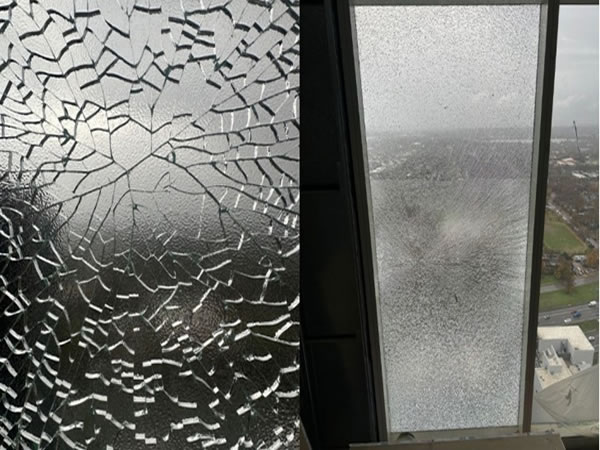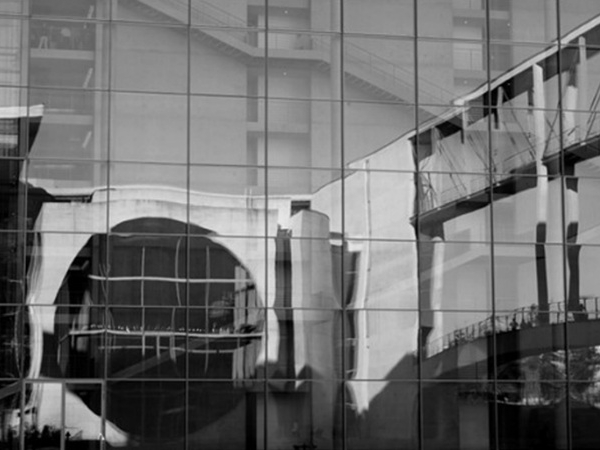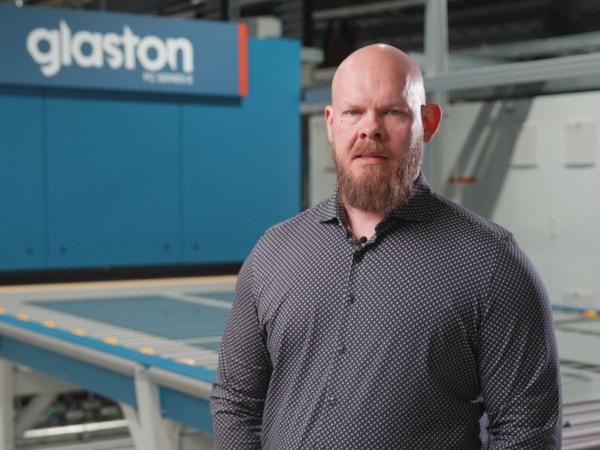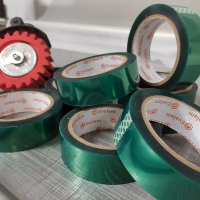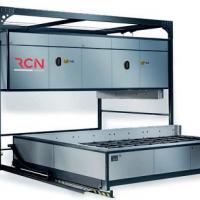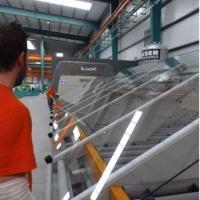Typical problems occurring during the heating process
Heating is the most typical stage of glass tempering; a lot depend on this stage to bring out the product of high standard. Quality of tempered glass is very much influenced by the heating process used in the furnace. Non-uniform heating causes deformation of the glass in the quenching process. The most common problem is caused by rapid heating of the lower surface of the glass due to conduction of the heat from the ceramic rollers. The resulting expansion of the lower surface bows the glass edges upwards and the glass moves on the rollers like a boat, resulting in damage called “centre line haze”. Other non-uniform heating results include overheated edges, which cause deformation known as bistable saddle and may result in breaking of edges during the heating process.
Coated Glass- A challenge for processors
The continuing move towards better energy efficiency in buildings is providing a strong push for the application of coated glass. Sputtered (off-line) low-E or solar control coatings are becoming standard in countries where climates are sunny the whole year or cold in winter and warm in summer. For glass processors with traditional technology this has meant a need to adopt somewhat slower tempering processes because of longer heating time. At the same time processors are hard pressed to boost their production capacity without compromising the aim for outstanding quality with all glass types.
Problems are far more severe when processing coated Low-E and reflective glasses. In addition to the problem of conductive heat from the rollers, the coating on the upper surface of the glass reflects the radiation from the upper heating elements, whereas the lower heating elements heat the glass twice, because the radiation from below penetrates the glass and is reflected back from the coated upper surface.
Uneven heat distribution may in turn occur when variable loads are run into the furnace one after another. When it enters the furnace, the cold glass absorbs the heat from the roller bed. Due to thermal inertia, the previous glass leaves the area where it has been oscillating cold, and consequently the next batch enters a roller bed which may have excess heat on the edges and a cold area in the middle. This can be partly compensated by adjusting the cross-sectional heat so that it only heats the loaded area.
Non-uniform heating may also result in cold streaks in the direction of the glass. Here the uneven temperature caused by the resistance elements gives rise to iridescence which is most clearly seen in a polarisation test, but may also be visible to the naked eye.
The glass itself may also cause problems in heating. Radiant heat is differently absorbed in printed areas of the glass than in plain glass. The same applies to shaped glass lites.
These problems may adversely affect the shape or flatness of the end-product, its optical qualities or the surface of the glass. Uniformity in heating is achieved by compensating the temperature difference by profiled heating; hence the key importance of having the option of profiled heating.
Convection for coated glass and speed
"Heat is transferred to the glass in three different ways: by radiation, conduction and convection. Regardless of the type of furnace, these three ways of heat transfer are always present. They can be further analysed into the following parts:
1. Radiation
Direct radiation
Indirect radiation
2. Conduction from the ceramic rollers .
3. Convection – It can be classified in three categories.
Natural convection.
Assisted convection by using compressed air.
Forced convection.
The extent to which each of these contributes to the heating process depends upon the type of furnace, the type of glass and the phase of the heating process. In traditional furnaces the main source of heat transfer is conduction from the rollers (in the initial phases of heating) and then radiation. In full convection furnaces, the heat predominantly transfers through convection. Convection must play a major role if coated glasses are to be heated effectively.
In order to overcome these problems, machinery manufacturers are on the constant lookout for new solutions that are based on the use of convection. Convection is seen as a must for any production line where coated glass is made. As well as helping to improve the quality of the end product, convectional heating has another important advantage over radiant systems, namely heating speed.
Tempering systems based on radiant furnaces heat up the float glass at speeds of about 40 sec/mm of thickness. With convectional heating, heating times can be reduced to 25-30 sec/mm of thickness, increasing output and productivity by up to 40-50%! As Low-E and other coated glass types require much longer heating times in a radiant furnace, productivity is increased even more. "(quoted from the article Convection gives the advantage, by Juha Karisola)
Disadvantages of Forced Convection
There are three negatives of forced convection tempering. First, it is difficult to control the convection currents inside the furnace and requires proper design in the equipment and operator skill. Secondly, forced convection tempering consumes about 10% more electricity due to indirect heating through air-jets. Additionally, forced convection machines are also more expensive to buy as well as maintain.
Edge Quality and Toughned Glass
Edge quality plays an important role during fabrication, shipping and installation of float glass products in automotive and architectural applications. The tempering process induces transient tensile stresses during early portion of tempering both on the surface and edges of float glass. Depending on the temperature and viscosity of glass these stresses may or may not be relieved by viscous relaxation before the permanent beneficial stresses begin to build in. In view of good quality of float glass the temporary tensile stresses can be sustained by the surfaces but not necessarily by the edges. Indeed, the edge quality which depends on the type of edge finish is inferior to that of tin and air side surfaces. Consequently, premature fracture may initiate at these edges if the combination of temporary tension and flaw severity is unbearable. Such a premature breakage occurs when the glass temperature is not high enough and the quench rate is too high. Glass breakage during tempering cuts down productivity and at the same time reduces glass quality.
Chinese Processing Machinery- Boon and Bane
No doubts that China is the most vibrant economy of the world, this day and Chinese glass industry is giving sleepless nights to the glass producers and processors worldwide, but alas this vibrant economy and its machinery producers have failed significantly when it comes to glass tempering machines, you can count on your fingers a few quality machine manufacturers ( I bet you wont exhaust even one hand ), but ironically Chinese tempering machines are mushrooming in every corner of the world, be it the most sophisticated market of North America , Western Europe or the developing countries like India, Vietnam or African countries. These Cheap machines are finding the market in most unlikely places, I mentioned this matter to a few glass processors in my country and invariably the answer was lower initial cost, however none of the processor mentioned that there is a problem with quality (though the plant managers have a different story to tell).
One doesn’t have to look very far, the way tempering machine manufacturers mushroomed in China, in a very short span of time tells the story itself. Look back five years back, there were five manufacturers of tempering machines in China, today you can count three dozens, and majority of them with hardly any R & D and selling at a cost nearly one third of European manufacturers . Though the lower initial cost has helped a lot of processors and new processors have bought these machines and has added to the volume of processed glass but in majority of the cases at the cost of quality. In my country has high as 75% of the tempering machines used are of Chinese origin.
By Seema Gahlaut
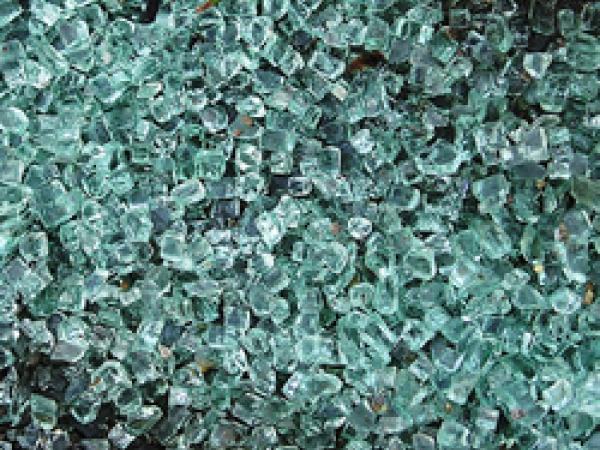
Date: 28 April 2008
Typical problems occurring during the heating process Heating is the most typical stage of glass tempering; a lot depend on this stage to bring out the product of high standard. Quality of tempered glass is very much influenced by
 600450
600450
Seema Gahlaut
2008-04-28T13:00:00
Glass Tempering: Issues and Concerns
glassonweb.com 
